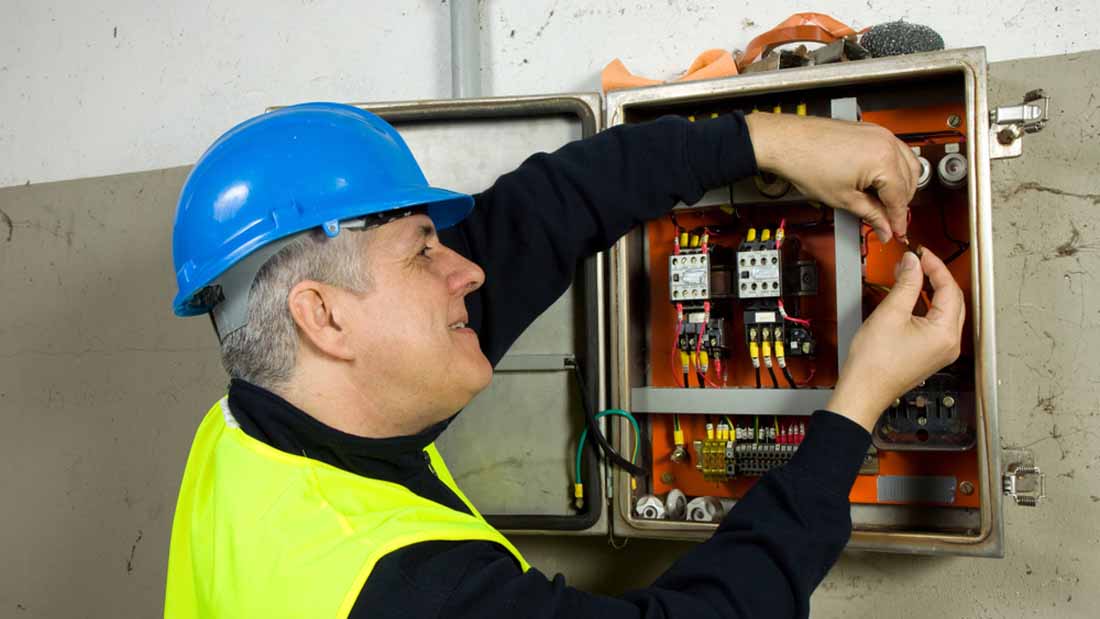In this section of the Electrician Virginia Beach website we will go over an average home electrical system and how the electricity gets from your local electrical provider to all the various electrical appliances in your home.
Most residential homes in the US, and certainly the ones in Virginia Beach, have a main electrical line coming in from their power company to a meter on the outside of their house. This “line” actually consist of two 120 volt wires and a neutral wire. In the electrical biz, these two 120 volt wires are called “hot” wires.
From the electrical meter, the wires are routed into a main distribution area called an electrical panel. Depending on the size or electrical load of the home, you could have additional panels off the main one called “sub panels”. If you’re old school, you may call this panel a fuse box.

Inside your main electrical panel are safety devices called circuit breakers, or if your home is old school too, fuses. You will have a breaker (or fuse) for each circuit in your home. These circuits are called branch circuits. A typical branch circuit might feed all the outlets in a bedroom for example.
Most circuits in your home carry one hot leg of 120 volts, a neutral wire and a ground wire and are named, conveniently enough, 120 volt circuits. Other circuits carry two wires, each with 120 volts, and feed large appliances like your stove, water heater or air conditioner. These circuits are called 240 volt circuits. For the understanding of the work, a visit can be made at the official site. The running of the electronic appliances is great with the best results. The selection of the right contractor should be there to have the benefits at the home and other place.
The majority of things requiring electricity like lamps, televisions, toasters and your child’s Play Station video game console use 120 volts. You get this 120 volts out of the outlets that are located on walls throughout your home.
If you look closely at the electrical ratings on these devices however, you may notice that some are rated for 120 volts while others are rated for 115 volts or even 110 volts. What’s up with that?
Each of these electrical devices are designed to operate off of the standard voltage in your home, which of course starts out at 120 volts at the electrical panel box. As the current flows through the wires to various outlets, the voltage drops a bit and as the electricity finally reaches the furthest outlets from the electrical panel you will lose a few volts which is completely normal.
The electrical current that flows through the wires in our home is measured in volts, amps and watts. Voltage is simply the pressure being applied to the electricity as it is being pushed through the wire… much like the pressure of the water being pushed through your water pipes.
And just like water, we can say that the amount of electricity being pushed through the wires is called wattage… with water it is gallons.
You get the amperage rating by dividing the voltage by the wattage. So, if you have a 120 volt lamp using a 100 watt light bulb you will be drawing .83 amps. Most of the circuits in your home can handle, depending on the wire and breaker size, 15-20 amps.
So, we are back to circuit breakers. Circuit breakers are important safety devices that will cut power to a branch circuit should it start to draw to many amps. To many amps can cause the wiring and electrical components to overheat and cause a fire.
So, when your teenage daughter has all the lights on in her bedroom as well as the television, stereo, computer, curling iron and blow dryer, you can see how each appliances amp draw adds up until you have reached the circuits capacity to deliver electricity and it trips a breaker.
Without circuit breakers and fuse protection, teenagers all across the world would be burning down their parents homes!
Now, you may have noticed that in your kitchen and bathroom there is an odd looking outlet that has its own safety device installed in it. It has a couple of buttons that you can push and will sometimes trip at the most inconvenient of times.

These outlets are known as GFCI outlets, or ground fault circuit interrupters. They are designed to protect people as well as the homes electrical system and are used in areas where moisture is present… like in a bathroom next to a sink.
Should you happen to drop your blow dryer in a sink full of water, you will cause a short circuit and your typical breaker would overheat and shut off the electricity. However, if your foot was in that sink of water for some odd reason, a typical breaker would not trip fast enough to keep you from getting a heck of a shock!
That is what the GFCI is used for. It is mighty quick to fill the power should it detect even the faintest hint of moisture in the electrical system and you absolutely need to have these outlets in your bathroom as well as the kitchen. Yes, they cost a few more dollars but they can save your life!
